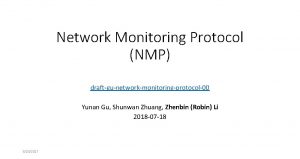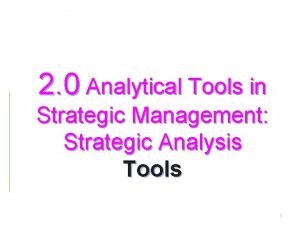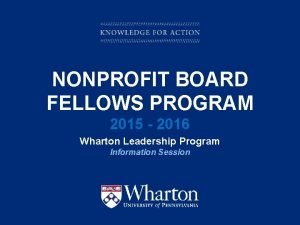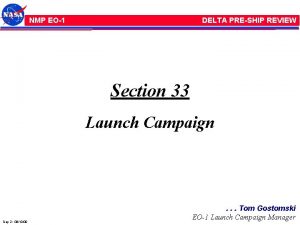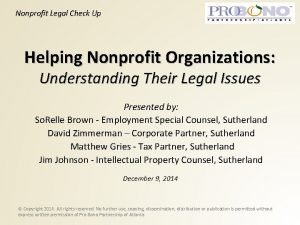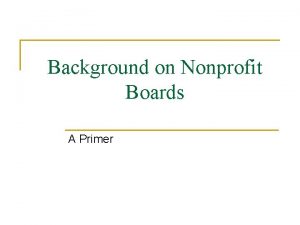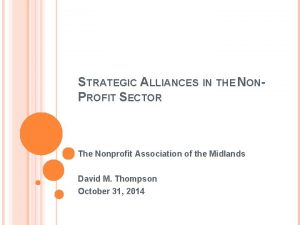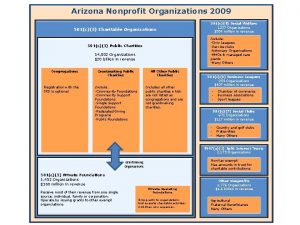Strategic Management in Nonprofit Organizations NMP 625 Analytical










- Slides: 10

Strategic Management in Nonprofit Organizations NMP 625 - Analytical Frameworks

Seven Stages of Nonprofit Capacity Nonprofit Lifecycles Stevens & Simon Five Stages of Nonprofit Organizations Presented by Susan Kenny Stevens (2008) Presented by Judith Sharken Simon (2001) Stage 1 Stage 2 Stage 3 Stage 4 Stage 5 Stage 6 Stage 7 • Stage 1 Imagine and Inspire • Stage 2 Found and Frame • Stage 3 Ground and Grow • Stage 4 Produce and Sustain • Stage 5 Review and Renew Idea Start-Up Growth Maturity Decline Turnaround Terminal

Susan Kenny Stevens, PH. D. Judith Sharken Simon

The Strategy Pyramid David La Piana • Operational Strategies – enhancing a nonprofits administrative efficiency, preparedness and execution. • Programmatic Strategies - Intended to increase programmatic impact • Organizational strategies – assist the nonprofit garner resources of all types as it pursues its mission

The Strategic Planning cycle David La Piana • Steps A B & C • These steps represent your organizational Identity. • Step D • Strategy Screens are created that assist in narrowing down key strategies. • Step E • The point in which you can recognize a strategic challenge as it arises. Framing the Big Question. • Step F • Develop and test strategies that are in response to something that the organization is facing. • Step G • Implement strategies and adapt continuously. A plethora of tools are at your disposal.

Strategy Screen Opportunity Matrix David La Piana The Strategy screen represents a set of criteria that an organization can use to choose whether or not a particular strategy is consistent with its identity. List each option to be ranked (i. e. program) along the top and numerically rank using criteria on the left to get the best possible choice.

“The Driving Force is the component of the business that is unique to that company and is a key determinant of the choice Driving Force The DNA of Strategy management makes with regard to future products, future customers and future markets” ( Robert, 2006, p. 55). Every Business has 10 Components Technology Know-how Production Capacity/ Capability Michael Robert Natural Resources Product/ Service Sales/ Marketing Method Distribution Method One component is the Driving Force of its Strategy Customer/ User Class Market Type/ Category Size/ Growth Return/ Profit

• The choice selected for the driving force will determine the Business Concept. Strategic Filter • Strategic Filters are constructed from the Business Concept. 1. 2. 3. 4. Does the Opportunity… Criteria presented… … Yes No ________ _______ • Utilize Bumper-Sticker Strategy. • Determine your Strategic Quotient. • Understand what is your Strategic IQ. What is the Strategic Quotient of your Organization? 1. Do you have a well-articulated, clear Statement of Strategy? Yes____ 10 No____ 1 2. Could each member of your management team write a one-or twosentence Statement of that strategy without consulting the others? All could____ 10 Some could____ 5 None Could ____1 3. …

Five Leadership Principles Move Beyond mission-vs money thinking. Financial Leadership Jeanne Bell & Elizabeth Schaffer Cultivate financial leadership on both staff and board. View the nonprofit business as an interdependent set of programs and activities. Recognize the relationship between strong infrastructure & programs Set the tone of being financially accountable and transparent. Six Key Accounting Practices for Nonprofits Treatment of restricted contributions Functional classification of expenses Employee time tracking Allocation of common costs Accrual basis accounting Capitalization and Depreciation

Bell, J. , Schaffer, E. (2005). Financial leadership for nonprofit executives: Guiding your organization to long-term success. Saint Paul, MN: Amherst H. Wilder Foundation. Resources La Piana, D. (2008). The Nonprofit Strategic Revolution. Saint Paul, MN: Fieldstone Alliance. Robert, M. (2006). The New Strategic Thinking; Pure and Simple. New York, NY: Mc. Graw-Hill. Stevens, S. K. (2008). Nonprofit lifecycles: Stage-based wisdom for nonprofit capacity. Wayzata, MN: Stagewise Enterprises.
 Nmp protocol
Nmp protocol ∠lmn is a straight angle. find m∠lmp and m∠nmp.
∠lmn is a straight angle. find m∠lmp and m∠nmp. Nmp recovery system
Nmp recovery system Przedszkole gdynia wolne miejsca
Przedszkole gdynia wolne miejsca Strategic analysis techniques
Strategic analysis techniques Industrial organization model of above average returns
Industrial organization model of above average returns Cultural aspects of strategy choice
Cultural aspects of strategy choice Wharton nonprofit board fellows
Wharton nonprofit board fellows Lhb 625
Lhb 625 5-1 writing linear equations from situations and graphs
5-1 writing linear equations from situations and graphs 625 s president st baltimore md 21202
625 s president st baltimore md 21202
